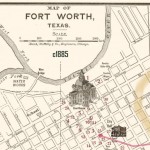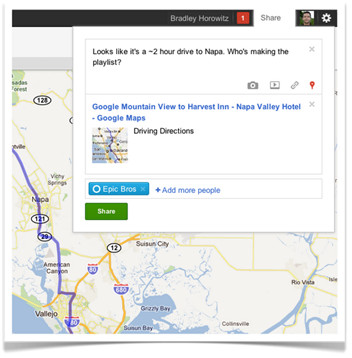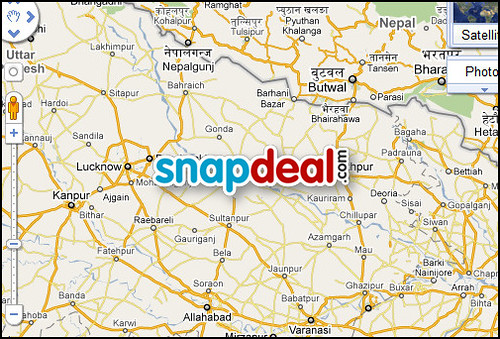Have you tried out Google Maps in “Treasure Mode” today?
I just noticed it late in the day. On the left side is a box for more information about the new beta program: (more…)
Have you tried out Google Maps in “Treasure Mode” today?
I just noticed it late in the day. On the left side is a box for more information about the new beta program: (more…)
 If you’ve ever tried to piece together the location of where some historical events occurred, you often will find that it’s very, very hard to do. I find myself doing this every so often, and each time I’ve thought that there is likely a large niche for a site which could attach timeline information to locations. There are often times when it would be useful (or interesting) to know what past events happened at a particular place, or to find the more precise locations for some notable historical event. Since there isn’t any central site for this sort of thing, people end up trudging around trying to find often-vague historical documents which mention the historical event, then try to match the historical locations up with current maps.
If you’ve ever tried to piece together the location of where some historical events occurred, you often will find that it’s very, very hard to do. I find myself doing this every so often, and each time I’ve thought that there is likely a large niche for a site which could attach timeline information to locations. There are often times when it would be useful (or interesting) to know what past events happened at a particular place, or to find the more precise locations for some notable historical event. Since there isn’t any central site for this sort of thing, people end up trudging around trying to find often-vague historical documents which mention the historical event, then try to match the historical locations up with current maps.
I found myself in this situation just this past week. I was half-watching Whitechapel, a crime mystery show set in England on BBCA, and the detectives had been in the home of a batty old woman who suffered from obsessive hoarding. Another character in the show was a sort of consultant for the police about historical crimes, and he’d mentioned a serial killer in America in the late 1800s, H. H. Holmes, who’d murdered potentially considerable quantities of people he’d lured into the hotel he operated, and the rooms were set up in some maze-like arrangement. Since Holmes was entirely unfamiliar to me, and since the whole story sounded so over-the-top, I figured it was fictional. But, not so! When I Googled this on my Android cellphone, I quickly discovered that there was indeed such a killer! (more…)
Google Maps has introduced “bubble ads” which feature an advertiser in the info bubble/tooltip that appears above pinpointed locations in the map interface. Mike Blumenthal points these out with a “rogue’s gallery” of inappropriate ad placements. I believe these must be the “big changes” alluded-to in Google insider rumors I reported upon a few weeks ago.
It’s not hard to find instances of ads which arguably should not be allowed to be displayed smack along with a business’s listings. Here’s one I just grabbed showing an ad below a local doctor’s listing — the ad urges consumers and potential patients to “Check for disciplinary action”, and has parsed the doctor’s name into the ad itself — casting an implicit aspersion upon the doctor, and potentially damaging the doctor’s conversion rate if the advertiser’s site has some sort of negative information about the doctor:
As Mike points out in his post, there are many cases of inappropriate ads showing up with these — and, it’s hard for me to find a whole lot of cases where an ad might be considered “appropriate” from the perspective of businesses “graced” with oddball ads. I can see where such ads would make sense for some landmarks and other non-business places, but for business listings themselves, such ads are at best distracting and at worst they are actually damaging to businesses’ referral rates.
From the perspective of small businesses, the new ads are far worse than having nearby competitors appearing on their profile Place Pages — these ads are visible at a higher level in the consumer research cycle, and interfere with the potential for users to move any deeper in clicking through to read more details about the business’s information. The related listings showing and ads which have been displayed on Place Pages are shown lower on the page and are not as prominent in the cycle as consumers seek provider information.
One has to wonder how Google can keep a straight face in claiming that the advertising side of the house is separated by a “firewall” from the search engineering side at this point!
One also wonders how Google intends to spin this to local businesses — it feels very extortionary — “you’d better advertise on your own listing, or we’ll let someone else take it hostage!”
This appears to be yet another of many instances where Google does a poor job in designing the online user-experience due to an obstinate refusal to do any sort of user experience testing or focus group testing for local business owners — which are one of the major constituent audiences which makes use of Google Maps. Not only does this new ad presentation *not* improve or avoid detracting from the user experience, it damages how Google is perceived in the eyes of millions of small businesses.
How is it helpful to Google Places to make local businesses feel downright hostile to your company?
The Atlantic Wire reported that Occupy Oakland protesters managed to get the name of Frank H. Ogawa Plaza to be changed in Google Maps to “Oscar Grant Plaza” — the name they dubbed it in remembrance of a man killed by BART police on New Years in 2009.
After media began noticing the unofficial name appearing in Google Maps, Google apparently corrected the error. I just did the search, and the plaza is showing the official name within the map, although you can see from the tooltip that some user had been encouraging people to post ratings under the protesters’ nickname for the place:
A Google spokesperson admitted that the name came from user-submitted edits, and that it shouldn’t have been approved, but should have been allowed as a “search reference”. I’ll translate: Google should not have pasted the name on the map as an official place-name, but should have allowed it to be added to their synonym database so that people searching on the name could easily find the location it refers to. As you can see from my screen-grab, it is now functioning as a search reference.
Concerningly, this incident supports what I have been saying, along with others, that Google Maps is particularly prone to Google-bombing from user-submitted content (“UGC”) edits. As I illustrated recently from Mike Blumenthal’s experiment to flag Google HQ as closed, some types of edits can result in businesses getting their listings defaced with false claims that they’re no longer open, and in even worse cases business Place Pages could get forced to rank for obnoxious terms, and labeled with descriptive terms that sabotage business referrals.
I could argue that it’s actually improper for the plaza to be made to rank for the unofficial name in this place, under the condition of a purposeful Google-bombing exploit. I can also argue that it’s useful and helpful for users to be able to search for places under their common nicknames and alternative spellings. But, I bend more towards this being an inappropriate association in this case. The edits were a type of vandalism intended to hijack place-names in maps in order to convey a political message represented by what was probably a relative minority (assuming the Occupy Oakland protest was a part of the nationwide protest movements sparked by Occupy Wall Street, it’s hard to fathom what a police killing in 2009 has to do with the outrage against corporate corruption and economic problems, other than perhaps some desire to kick up the drama a notch or to appeal to a subset of protesters who desire to associate themselves with a sort of iconic martyrdom).
Considering how there are relatively few checks and balances in place, it’s really not surprising that a mob of people can hijack a place name in Google Maps and change it to communicate their political message. This sort of thing is happening on a much smaller scale to hundreds and thousands of businesses which are unfairly harmed by similarly applied user edits.
While it’s great that consumers have a greater voice in this Business 2.0 age, I think some more balance needs to be brought back to “The Force” by way of limiting the easy manipulation of Google Places and it’s vulnerability to such exploits.
I’ve written a few times about corn field mazes which can be seen using Google Maps – enter the newest “skyvertisement” promoting Whole Foods at P Bar Farms:
It’s not the first time “crop art” or corn field maze designs have been used to promote a company. (more…)
I happened to see Greg Sterling briefly at SMX East today, and he alerted me that Google announced that they’ve launched “+snippets” for Maps, allowing users to share Google Maps pages with their friends in Google+:

Could this be what the “big changes planned for Google Maps” rumor I earlier reported was referring-to? (more…)
Quite a few sites have reported on how Shiv Nagar, a village in India, has renamed itself “SnapDeal.com Nagar”, out of gratitude to the company which paid to give them running water. But, I don’t think anyone’s reported on how this is going to give SnapDeal.com a free mapvertisement in Google Maps and Bing Maps.

Shiv Nagar, India, renamed itself SnapDeal.com
It appears that this was not intended to be a guerilla marketing tactic, but it is a defacto bit of commercial promotion, and once the town’s name becomes changed on maps it will become “mapvertising”.
As you may recall, I’ve written before about how corporate sponsorships can result in towns getting renamed after companies and products (here and here), and (more…)
Google has just announced that they’ve launched “Descriptive Terms” to appear with business listings in map search results. According to them, these descriptive terms are some of the most common terms found in user reviews, blogs, web pages and other online references which describe the business. For instance, if you search for “Barbeque Restaurants”, you might see a business which lists such items as “banana pudding”, “pork chops”, “texas style”, “baked potato” and “chicken poppers”:
So, the cool part of this idea is that the feature will highlight user-generated terms which are frequently used in reference to the business. This is a type of an ontology formed by the vox populi, or common man. More properly, these Descriptive Terms begin forming what’s known as a “folksonomy“, which started coming into vogue with social media, particularly around the concept of tag clouds.
(It’s very slightly ironic that Google Maps has now deployed what are essentially small tag clouds with business listings, since I’ve heard some Google Engineers mildly disparage tag clouds as being potentially un-userfriendly and potentially bad on sites in some cases!)
But, the really UNCOOL part of the new Descriptive Terms is that Google appears to’ve launched these willy-nilly without properly safeguarding against sensitive/bad terms that they can end up highlighting.
With very minor testing, I can see numerous instances where the terms selected by the algorithm are inappropriate and unfairly damaging to the businesses. (more…)
So, we’ve seen UFOs in Google Maps, illegal activites, marriage proposals, earth art, and more. Since I’ve reported on all sorts of cool things to see in Google Maps (including corn field mazes, advertisements, and more), I’ve decided to also report on the latest — a juvenile prank that’s now gotten a lot more publicity than was perhaps originally imagined. Yes, I’m sad to say that penises have now invaded Google Maps!
It seems that some students at New Zealand’s Fairfield College decided it would be funny to lay down phallic patterns of weedkiller on the school’s lawns, according to Stuff.co.nz. By the time the landscaping maintenance personnel realized what had happened, the penis-shaped patterns were already showing up. The maintenance people tried obliterating the definition of the patterns with more weedkiller, apparently killing all the grass.
But, not before Google’s satellite/aerial cameras caught the scenes. (more…)
Church Launches World’s Largest Chalk Painting ‘Skyvertisement’
Saturday, April 19th, 2014I’ve mentioned before how my church, Fellowship Church, has leveraged their position directly in the landing path zone near DFW Airport to promote themselves through the use of a huge logo painted directly on their roof — a form of ‘Roofvertising‘, as it were. They’ve now done yet another type of “Skyvertising” by painting a huge chalk portrait of Jesus on the church parking lot:
Fellowship’s Chalk portrait of Jesus. The chalk portrait coincides with the week leading up to Easter holiday weekend, and the chalk painting is a form of skyvertising. Aerial Photo Credit: WFAA
While this is clearly more of a novelty and a PR ploy to remind people that this is Easter weekend (many people only attend church twice per year — Easter Weekend and Christmas services), roofvertising and skyvertising are actually serious forms of marketing that can often reach a great many people who are exposed to the promotions when they fly over them or see them when browsing through satellite imagery and aerial photos in Google Maps, Bing Maps, Mapquest, and other mapping applications. KFC’s “Space Ad” — an image of their iconic “Colonel” mascot/logo built at large scale out in the desert of Nevada — was probably the most famous example of this type of marketing.
Fellowship’s chalk portrait of Jesus certainly allowed them to abruptly stand out from the crowd of other churches all vying for attendees this weekend. Many churches do little more to promote themselves at Easter than to hang a large banner outside. (more…)
Tags: aerial photos, church marketing, Fellowship Church, publicity stunts, roofvertising, satellite images, satellite photos, skyvertising
Posted in Advertising, Bing Maps, General Commentary, Google Maps, Location Marketing, Maps & Mapping, Paintings | Comments Off on Church Launches World’s Largest Chalk Painting ‘Skyvertisement’